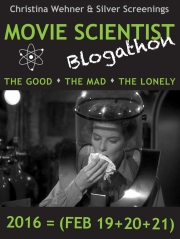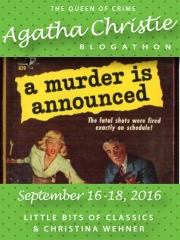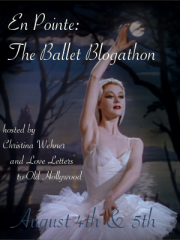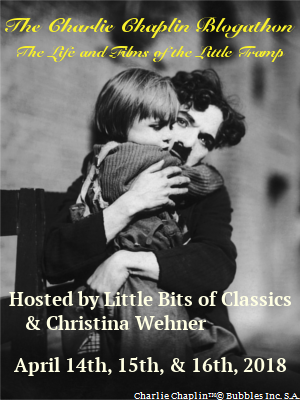 Ever since reading FictonFan’s and Silverscreening’s reviews of Alfred Hitchcock’s The Lodger, I have been doubly curious to see the film, which is also my contribution to Coffee, Classics, & Craziness’ “The Alfred Hitchcock Blogathon 2017.” It was the third film that Alfred Hitchcock directed, but is the one that he considered essentially his first film, the first to be recognizably Hitchcockian.
Ever since reading FictonFan’s and Silverscreening’s reviews of Alfred Hitchcock’s The Lodger, I have been doubly curious to see the film, which is also my contribution to Coffee, Classics, & Craziness’ “The Alfred Hitchcock Blogathon 2017.” It was the third film that Alfred Hitchcock directed, but is the one that he considered essentially his first film, the first to be recognizably Hitchcockian.
The Lodger is one of many film and stage adaptations of the novel by Marie Belloc Loundes, published in 1911 and inspired by the Jack the Ripper murders in 1888. Hitchcock’s film, however, appears to be set in 1927, though there is a definite gaslight and Gothic ethos. Ivor Novello, who plays the mysterious lodger, would have made a fantastic Dracula, actually.
The film opens with a silent scream.
Neil Brand, who wrote the contemporary score for the version I saw, has the orchestra scream along with the image. The scream reminded me of Hitchcock’s later close-up image of Janet Leigh screaming in the shower in Psycho. The beginning of The Lodger is really excellent and demonstrates Hitchcock’s visual skill, which requires minimal inter titles to explain the action. A blonde girl (Hitchcock already demonstrating his preference for blonds) has been murdered. There is one witness, who says she saw a tall man with a scarf wrapped around the lower half of his face. We see the police, the curious spectators, the ghoulish interest, the press, everything in a rapid fire of images (including a brief glimpse of Hitchcock). We also see a sign for a show called “Golden Curls.” The image of the sign will show up mockingly throughout the film.
The story then shifts to Mrs. Bunting (Marie Ault), her husband (Arthur Chesney), their daughter Daisy (June Tripp…who has golden curls), and the boyfriend/policeman Joe (Malcolm Keen). Joe and Daisy flirt with a heart-shaped cookie cutter and some dough, once again demonstrating Hitchcock’s flair for visual storytelling. Into this tranquil and domestic scene comes…the Lodger! Who looks like Dracula, or at the very least his cousin.
The lodger is definitely a strange young man, who doesn’t like pictures of women with golden curls in his room and has a habit of looking tormented by some inner turmoil. Not to mention pacing restlessly in his room, which is shown with a glass floor that shows him walking while the Buntings look up at the ceiling, the visuals of his footsteps almost making us “hear” the sound of his footsteps that the Buntings actually hear. When the lodger’s not looking creepy, he looks like Lord Byron, all sensitivity and anguish.
The tension in the film comes from Mrs. Bunting and her husband beginning to suspect that their lodger is the mysterious killer after he sneaked out at night and was gone during the time when another golden-curled woman was murdered. Their anxiety is heightened when he shows a strong interest in Daisy, who does not see anything wrong in the lodger’s behavior. Joe, on the other hand, grows increasingly jealous.
It’s quite an exciting, atmospheric film and really shows Hitchcock’s ability to create tension visually rather than via words, as well as hitting on a number of themes that he would explore later. And if you have never seen it, I would definitely recommend watching it before reading the spoilers section below.
(Spoilers) I have to admit that I knew the surprise ending before coming into the film, that the lodger is actually, incontrovertibly innocent (unlike Laird Cregar’s lodger in the 1944 film), but I was curious how it would play out. The lodger’s innocence had a rather odd affect, I thought, somewhat like the affect of Hitchcock’s later Suspicion, though far less egregious. It makes Ivor Novello’s performance both sinister and romantic, which makes him a creepy lover. At one moment, he is stalking Daisy to her job as a model and buying her the dress she was modeling (it’s obvious that he’s a well-off young man, socially far above Daisy) and another moment gazing soulfully into her eyes like a young man with bad case of puppy love. In fact, the second part of the film feels more like a romance than a mystery or thriller.
I also have to admit that my view of the characters is somewhat colored by the fact that about two-thirds of the way through the movie, my sister labeled the two romantic leads as “pretty ninnies.” This is partly because the plot is not consistent. If he’s innocent, why didn’t he go to the police? Why did he run? Why is she standing by him, even though she knows nothing about it. They do not behave rationally. But they certainly look pretty while their doing it…especially Novello.
It is interesting to note that never again would Hitchcock have a woman place such unreasoning faith in a man for no reason. In The 39 Steps, Madeleine Carroll initially tries to turn Robert Donat in, Eva Marie Saint “helps” Cary Grant because she’s really working for the villain, Grace Kelly is simply turned on by the fact that she believes Cary Grant is a criminal in To Catch a Thief, and in Sabateur Priscilla Lane also initially tries to turn Robert Cummings in.
Regarding the ending, however, I’ve noticed that there is a theory floating around on the internet about another possible interpretation of the end of the film, which jives with my own impressions. Perhaps he really is the killer after all! Hitchcock originally meant to have the ending be ambiguous, but when Ivor Novello was cast, he was forced to change the script so that the leading man (rather like Cary Grant in Suspicion) would be innocent. But quite a few questions go unanswered. Like who killed the lodger’s sister and why? His sister was the first victim, but she died in the middle of a ballroom when the lights are turned off. Whoever killed her had to be someone in upper class society. But her murder doesn’t fit with all the other murders that come after, which seem to be happening in the street. Which makes one wonder if the lodger really killed his sister and went on a mad spree afterwards, until he saw Daisy, who perhaps reminded him of his sister.
It’s just a theory, but it seems odd that Hitchcock would make the lodger’s mansion look so creepy and Gothic. I half expected him to greet Daisy and her parents by saying, “I am…Dracula.” And then when they embrace, we can see the sign “To Night – Golden Curls” blinking in the background. Is it meant to be portentous of what is to come? Evidently, Neil Brand, the composer, thought so because as the lodger and Daisy embrace, the music grows gradually more ominous. Hmm.

Why is the sign “To Night Golden Curls” blinking in the background? Is that meant to be ironic or prophetic?
This post is my contribution to “The Alfred Hitchcock Blogathon 2017.” Be sure to check out the other posts, which can be found here.

















FictionFan
August 13, 2017 at 6:34 pm
A fascinating theory! I didn’t get that impression about the final scene and I’m wondering if it’s because I listened to the Nitin Sawhney score. I just went back and listened to the last five minutes, and it goes into total soppy mode – real love music with nothing at all ominous. Intriguing. Unfortunately I can’t track down the Neil Brand one on youtube – I shall keep trying. Therefore, I took the Golden Curls in the window to be a kind of hint that her past life was over as she moved into the world of the rich. But it is curious. Especially since the book ends very differently and Hitch was kinda forced to make Ivor Novello sympathetic by the studio, I understand. So who knows if he was being quietly subversive…
Glad you enjoyed it, and thanks for the link!
LikeLiked by 1 person
christinawehner
August 13, 2017 at 8:10 pm
It’s amazing the difference music can make! Perhaps it really only was the score that made me think that way, though it is awfully fun to think Hitchcock was undercutting the apparent happy ending. I heard the Neil Brand score on the Criterion Collection version, though I’m not sure if he scored it specifically for Criterion or if it accompanies other releases of the film. Did you enjoy the Sawhney score? It would be interesting to watch that one and see how differently the film feels with two different scores.
It also makes me wonder very much, as you mentioned in your post, what the original music was like and if they had original music. Wasn’t Hitchcock later very particular about the music for his films?
LikeLiked by 1 person
FictionFan
August 14, 2017 at 4:35 pm
Overall I enjoyed the Sawhney score very much though just occasionally it didn’t seem quite in synch with what was going on. And half way through when Daisy and the lodger were falling for each other, it suddenly breaks into a sung love song, which seemed so out of place. Yes, I’d like to know if there was an original score, though the fact that I haven’t seen any mention of it around the internet makes me think there couldn’t have been one or that it’s lost. I think Hitch must have been particular because generally speaking the music in his films really adds to the atmosphere…
LikeLiked by 1 person
christinawehner
August 14, 2017 at 5:16 pm
True, it is hard to image some of his films at all – North By Northwest, Vertigo, Psycho – without the music. Especially those scores by Bernard Herrmann. I think they are fused in my mind in association with Hitchcock’s films. 🙂
LikeLiked by 1 person
Erin
August 13, 2017 at 8:22 pm
I just saw this for the first time last month. Somehow I had gotten it into my head that the ambiguous ending that Hitchcock wanted (which he discussed briefly in Truffaut’s book) was the actual ending, so I was surprised by the way it turned out. That theory is very interesting, and one that I’ll have to keep in mind next time I watch it. I did remember thinking it was a bit odd (and possibly ominous) that the “Golden Curls” sign popped up again… You made a great point, too, about the later female characters in Hitchcock’s movies being warier about suspicious men.
LikeLiked by 1 person
christinawehner
August 14, 2017 at 12:43 pm
Thanks! I do appreciate that Hitchcock usually gives his female characters some motivations for helping the men. It can be so frustrating when a female character is obliged to stick by a man with a dubious character just because she “knows” that he isn’t bad. Could he be exploring that theme in Suspicion, too? Apart from the ending, she is forced to finally realize that her blind devotion has been willful?
That sign is rather ominous, isn’t it! It seems really clever how Hitchcock used the sign through the film…it seemed to get more sinister as the movie went along. Though perhaps one could say that it shows how the sinister connotations have now been diffused through love at the end, but it still seems to leave unanswered questions.
LikeLiked by 1 person
Erin
August 14, 2017 at 3:50 pm
Yes, I thought about Suspicion too, and I think it fits well with the other examples. As for the sign, I suppose it could go either way — either it’s no longer sinister like it once was, or it’s hinting at something ominous.
LikeLiked by 1 person
christinawehner
August 14, 2017 at 5:14 pm
It does seem like Hitchcock, at the very least, is having a good joke at our expense, teasing us a little with the sign.
LikeLiked by 1 person
Erin
August 14, 2017 at 5:21 pm
Agreed!
LikeLiked by 1 person
maddylovesherclassicfilms
August 14, 2017 at 3:10 am
Excellent post. I love this film, and I also had not read what you did into the ending. Will have to watch again with this possibility in mind. Personally I like an open ending where it’s hinted that perhaps what we think we know isn’t true at all.
LikeLiked by 1 person
christinawehner
August 14, 2017 at 2:37 pm
Thanks!
True! It’s gratifying to have room to be able to bring one’s own thoughts about what will happen after the film is over. Feels more like a participation than simply viewing.
LikeLike
Silver Screenings
August 14, 2017 at 4:14 am
Haha! Ivor Novello would make a fabulous Dracula!
Thanks for the link because I was curious to know what you thought of the film. I have to admit I had the sound on “mute” when I watched this – long story – so it was interesting to see how the score you listened to enhanced the viewing experience.
I like your impressions of the ending, and I think it makes the most sense. At first, I thought this was a “cop-out” ending, much like Suspicion, but I prefer your interpretation of subversion.
LikeLiked by 1 person
christinawehner
August 14, 2017 at 2:45 pm
Yes, it does seem a bit emotionally disappointing at the end, like Suspicion. It’s funny how Hitchcock kept running into the problem where studios did not want their leading men to be villains. Now, it seems like most people prefer to play villains or feel that villains are the better roles.
How was the experience of watching it silently? I’ve wondered if the visual emotion is more palpable in a well-made silent film than in a talkie and if you could feel emotion simply from looking at the images.
LikeLiked by 1 person
Silver Screenings
August 14, 2017 at 5:48 pm
I LOVED it as a completely silent film. When On its own, it has a lot of impact – I had almost forgotten I had it on mute. I prefer to watch silents that way, because sometimes I find the music too distracting.
LikeLiked by 1 person
christinawehner
August 14, 2017 at 5:54 pm
Oh, very interesting! I was once teaching a class on silent film and one woman remarked that it seemed as if directors were using visuals in the way music is used today, to set the emotional tone. I was really struck by that and it sounds like your experience is similar?
I’ll have to try watching a silent film that way now. Perhaps that would be a great way to approach teaching some silent films, too. Perhaps to highlight the impact, as you say, of the visuals and attune our senses to seeing rather than hearing.
LikeLiked by 1 person
Silver Screenings
August 14, 2017 at 6:05 pm
I really like what that woman said. I agree with her.
I find I don’t miss the music when I watch a completely silent film. The reason the music feels distracting to me is because I feel a little manipulated by it.
LikeLiked by 1 person
christinawehner
August 15, 2017 at 11:04 am
Do you find that the music in a talkie film can be manipulative, or is it the redundancy of manipulative musical emotion combined with the emotion already indicated visually in a silent film?
I once read that Ozu, the Japanese director, felt that the music played during his silent films should not necessarily reflect what was going on onscreen. I wonder if he felt the same way.
LikeLike
Silver Screenings
August 15, 2017 at 6:52 pm
Music in a talkie can be manipulative, but I don’t mind it. Maybe it’s a double standard?
My 1st introduction to silent film was as a teen with Laurel & Hardy shorts. They aired early Sunday mornings (6:00 am), so I watched them on mute because I didn’t want to disturb my family. Maybe that’s where the totally silent preference comes from.
Interesting what Ozu said about music not necessarily matching the action on screen. I need to see his films. Any recommendation for a starting place?
LikeLiked by 1 person
christinawehner
August 15, 2017 at 10:01 pm
Tokyo Chorus is a great place to start for his silent movies. His films are still mostly comedic (he admired Harold Lloyd), but beginning to move towards drama. For his later films, Early Summer (though his most famous is Tokyo Story) is the film that introduced me to him.
I’ve actually really fallen for Ozu. I started watching them several months ago and I think I identify more with his portrayal of the family than I ever did in any other movies I’ve ever seen.
LikeLike
christinawehner
August 15, 2017 at 10:03 pm
Oh, I wanted to say I’d love to know what you think of Ozu!
I actually started watching a silent Ozu film yesterday without any music and it’s interesting how the mind seems to supply all the sound and voices. It’s kind of like watching a visual book in how it felt for me (I need silence to be able to concentrate to read).
LikeLiked by 1 person
thestoryenthusiast
August 15, 2017 at 7:52 am
I have never seen any of Hitchcock’s silent films, which is an experience I really must pursue. Your review of this is so witty and interesting that I really must watch The Lodger.
LikeLiked by 1 person
christinawehner
August 15, 2017 at 10:53 am
Thank you! Yes, it is very interesting experience to see how Hitchcock developed his style early on before there was sound.
LikeLike
Realweegiemidget Reviews
November 20, 2017 at 5:53 am
Remember reading about this film in relation to the Jack the Ripper murders, had no idea it was Hitchcock – thanks for more about this movie.
LikeLiked by 1 person
christinawehner
November 20, 2017 at 11:33 am
I hadn’t been aware he had made this film initially, either. Though it’s a great fit for him. I’m actually curious to read the book, now.
LikeLiked by 1 person
Realweegiemidget Reviews
November 20, 2017 at 11:41 am
Definitely worth me checking out the film after your fab review. Had always wanted to know more so was great to see you’d reviewed it.
LikeLiked by 1 person
christinawehner
November 20, 2017 at 11:44 am
Would love to know what you think after you see it!
LikeLiked by 1 person
Realweegiemidget Reviews
November 20, 2017 at 11:45 am
Will tag you when I write about it!
LikeLiked by 1 person
christinawehner
November 20, 2017 at 11:45 am
Thanks so much!
LikeLiked by 1 person
Realweegiemidget Reviews
November 20, 2017 at 11:47 am
No problem.
LikeLiked by 1 person